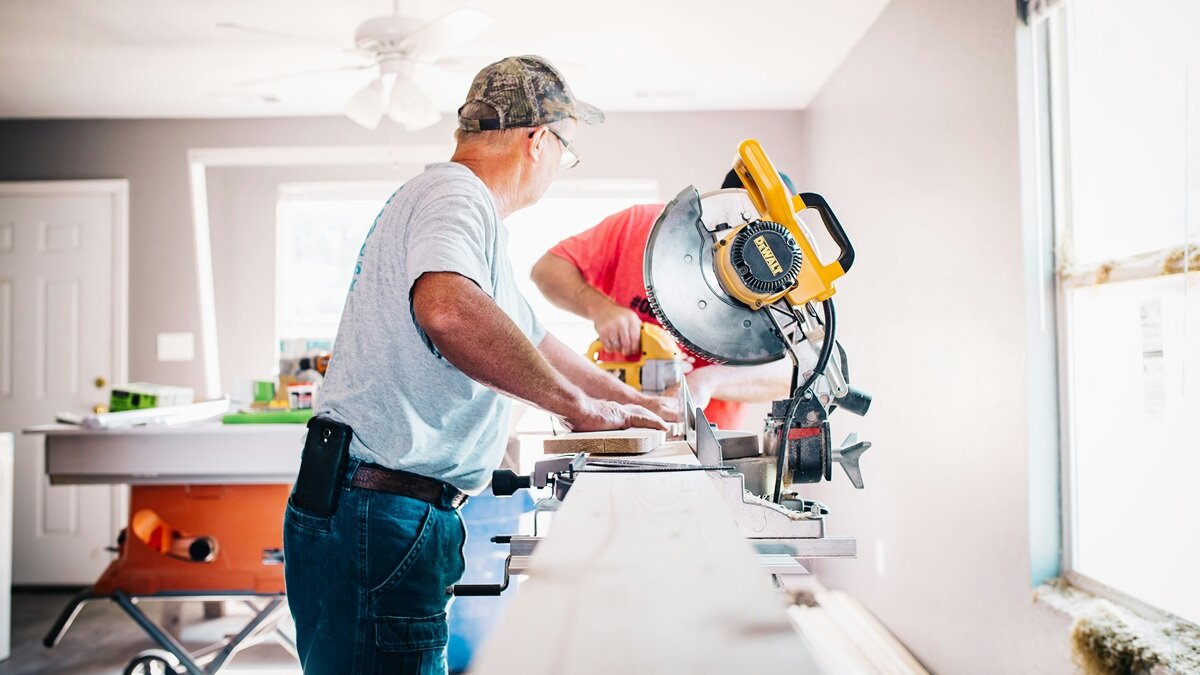Renovation and extension work can demand a lot of time and money – and it's tested the patience of many a homeowner over the years. Still, the benefits of remodelling a home often outweigh the drawbacks, and might include:
- Enhancing your property's market value
- Tailoring your home to lifestyle needs
- Accommodating changing space requirements (like an extra bedroom or bathroom)
- Improving layout and functionality
- Refreshing aesthetics and modernising outdated features
- Boosting energy efficiency
- Integrating smart home technology
Of course, your reasons may be entirely personal – there's no single 'right' reason to renovate. There are dozens, if not hundreds of reasons an Australian homeowner might choose to undergo a property renovation or extension.
Those that do, though, should take the time to fully consider all the ins and outs of home renovation before they begin.
What to consider BEFORE renovating or extending a house
#1. What's your intent?
Before you start scrolling Pinterest or researching trades, take the time to sit down and analyse what you want and need out of your home renovation.
You might want to upgrade your home, improve its energy efficiency, replace services that have fallen into disrepair, make your property more appealing to tenants, or garner higher offers from potential buyers.
Different goals may require a different approach from the start. Knowing your intent will help you to guide your decisions and find the right team to help it come to life.
#2. The scope of your home renovations
Asking for quotes or advice on remodelling or extending a property is akin to asking 'how long is a piece of string?' The answer will differ depending on your property, the changes you're after, your personal tastes, and your available budget.
For instance, a renovation needed to attend to issues with a home's structure or services is a different beast than one intended to be purely cosmetic.
#3. Return on investment
It might also be worth considering any potential return on investment (ROI) you might realise from renovating or extending. That is, whether you might profit from changes on the sale of the property.
If this is your goal, it's important to consider any works carefully. Any profit potentially realised from renovations will probably depend on the works being done, the property's location, value, and condition, and the ultimate buyer's expectations.
"If you have a $5 million house in the eastern suburbs of Sydney and you put in a flat pack kitchen, that won't add value at all – it's the opposite," Sydney-based interior designer and building designer Martina Hayes told Your Mortgage.
"But also, if you have a contemporary family house, but the kitchen is on the small side for a family, … I would definitely recommend my clients think about relocating a wall to make that kitchen bigger because if you put in a new kitchen, it can merely devaluate your property.
"Every potential buyer will see the kitchen and think, 'okay, this new kitchen is priced into the asking price, and it doesn't work for us as a family because it's too small', so a renovation can backfire."
#4. How you will achieve your house renovation, remodel, or extension
After you've locked down what you want to achieve, the next question will likely be how.
There are a multitude of ways to complete a renovation. You might want to do the whole thing yourself, project manage individual trades, or be completely hands-off and hire a building company to complete the project.
How you choose to approach your renovation will likely play a large part in its cost. And what might appear the cheapest option now could work out to be more expensive in the long run – as may be the case if you're choosing to learn as you DIY.
At this stage, it's probably worth considering various trades and reaching out for quotes, remembering the cheapest option isn't always the best. And, depending on what you want from your property remodelling, you might need to hire an architect or designer to create a plan to work off.
Strategic ways to fund home renovations or extensions
All that will likely lead an astute property owner dreaming of renovations to the ticket price of their vision. And that ticket price might leave them scrounging for cash.
According to the 2023 Houzz & Home Renovation Trends Study, Australian homeowners undergoing renovations spent a median of $35,000 in 2022, with those in the ninetieth percentile spending $200,000.
So, how can homeowners fund renovations?
Savings
The most common way to pay for a renovation project is by using established savings.
Paying with cash means there are no interest charges associated with a renovation but it might also mean that a homeowner is left scrambling in the case of a budget blowout.
Further, not all homeowners have a stack of cash tucked away in a savings account to put towards a renovation project.
Equity accessed through extending home loan
Those with a mortgage might be able to release equity from their home loan to fund their renovations. They may also consider refinancing to get access to the equity built into their bricks and mortar.
See also: How to choose a home renovation loan
Credit card or personal loan
Personal loans and credit cards can also grant access to funds that can be used to pay for renovations. The two products are typically easy to take out and various providers can offer various rates to various customers.
It's worth bearing in mind that interest rates on personal loans are generally higher than those on home loans, and those charged on outstanding credit card balances are typically higher again.
Construction loan
Finally, if you're considering a major renovation, taking out a construction loan might be the way to go. Funds from a construction loan are generally paid out by a lender as an owner needs them, with principal repayments beginning on completion of construction.
Here are some of the most competitive construction loans on the market right now:
Lender Home Loan Interest Rate Comparison Rate* Monthly Repayment Repayment type Rate Type Offset Redraw Ongoing Fees Upfront Fees Max LVR Lump Sum Repayment Extra Repayments Split Loan Option Tags Features Link Compare Promoted Product Disclosure
What is overcapitalisation?
Overcapitalisation happens when the renovations that you made do not raise the value of your home high enough for you to recoup the cost of the upgrades should you decide to sell your property.
Spending $250,000 on home improvement projects that add only $100,000 to the value of your property, for example, will cause you to lose $150,000 when the time comes to sell. Simply put, you will have overcapitalised on your home by $150,000.
However, you can avoid this costly mistake with proper planning and preparation. Here are some of the things you need to do before embarking on your next renovation project:
1. Know how much your home is worth.
To have an accurate estimate of the value of your home, it is advisable to get a professional property valuation. You can also do research on the prices of different homes in your neighbourhood. Normally, different areas have different price caps or thresholds that buyers or even tenants are willing to pay for.
Understanding how much your property is worth and how it compares to other homes in your area will give you a clear idea on how much you can spend on renovations and what type of upgrades you can do without going overboard.
If you are planning to upgrade an investment property or put your property in the market in the foreseeable future, the ideal renovation budget is about 10% of your home’s value – so, if your house is worth $850,000, allocating $85,000 to home improvement projects is reasonable. But if you intend to live in your home long term and do not have any plans of selling it yet, you can risk spending more on features that can make your home more comfortable and attractive.
2. Understand what type of renovations add value.
There are certain areas in your home – with the right renovations – can add tons of value. The key is focusing your home improvement efforts on the areas with the highest potential to generate returns on your investment.
Most property experts list the kitchen and bathroom as among the vital renovation areas that can easily increase your home’s value. The property’s façade – which is the first thing potential buyers see when they check out your home – is another location that can stir buyer interest. Large family rooms and outdoor living spaces are also favourites among house hunters. Eco-friendly features such as energy-efficient lighting and appliances are becoming increasingly popular as well.
On the other hand, some features may put off buyers because of the high-maintenance costs, including swimming pools, extensive landscaping, and retrofitted HVAC systems.
3. Set a budget and stick to it.
Setting a clear budget before the process starts ensures that you do not overspend on renovations. It also allows to get your finances in order and focus on home improvement projects that you can afford.
4. Create a broad appeal.
If you are renovating to sell your home, it is crucial that you consider what upgrades will appeal to a wide array of buyers. This way, you do not limit the number of interested buyers. You may find fancy décor or brightly coloured tiles attractive but not all buyers share your tastes. To sell your home faster, it is best that the renovations create a universal appeal where it is easy for buyers to envision themselves living in the home.
Beware of overcapitalising during renovations or extensions
So, you've worked out what you want to achieve through renovating, remodelling, or extending your property, how you plan to reach your goals, and how you will pay for it. Now, it's time to balance the risks and rewards.
Namely, the risk that the cost of renovating or extending your property will be greater than the value-add of said renovation or extension – often called overcapitalising.
Perhaps the simplest way to avoid overcapitalising is to do your research. Look at what properties similar to yours are selling for compared to those similar to your end goal.
You might find that adding a pool at a cost of, say, $80,000, may add just $20,000 of value to your property. Of course, if you want the pool to enhance your life it might be worth the sunken cost. But if you're adding the feature to attract a future buyer it mightn't be the best use of your cash.
Budget blowouts can also result in overcapitalisation. Be wary of projects that are at the top of your budget to begin with as you might be left with little wiggle room in case of an unexpected increase in costs.
Ms Hayes recommends homeowners speak with local agents to estimate the likely resale value post-renovation and determine whether renovating is in their best interests.
Expert advice to maximise return on investment when renovating or extending
Ms Hayes has a wealth of tips for homeowners looking to maximise their return on investment when renovating or extending their homes. But, if it all seems to much, she advises people reach out for professional advice.
"Interior designers can help," she said.
"Even if you don't want help with everything, you can usually get an hourly package with an interior designer, that's not so expensive … and you then pick the most important areas [to receive advice on].
"They can help you with tile selection in the bathroom, or cabinet and bench top selection in the kitchen, for instance."
How to maximise ROI in a kitchen renovation
The kitchen is often truly a home's heart – some buyers judge a whole property by it. A standout kitchen can attract interest from buyers and a strategic kitchen renovation could result in substantial return on investment.
"[A renovated kitchen] needs to align to the location, the style, and the proportion of the house and, of course, keep it neutral so it it matches a lot of peoples' taste," Ms Hayes said.
"What I would be looking for is functionality – people like a functional and a beautiful kitchen.
"If possible, definitely do an island bench with two to four bar stools, depending whether it's a unit or a family house."
Key takeaways:
- Match the kitchen to the home's style, size, and price-point
- Prioritise both functionality and aesthetics
- In higher-value homes, stone benchtops and polyurethane cabinetry signal quality
- Where space allows, an island bench with seating is high on buyers' wish-lists
View this post on Instagram
How to maximise ROI in a bathroom renovation
While kitchens are commonly a showstopper, bathrooms can also pull on the heart strings of potential buyers.
"In bathrooms, I try to keep things clutter free, minimal, a neutral color scheme, ideally just a shower screen if that works the bathroom, a wall hung vanity, and rather good tap wear," Ms Hayes said.
Key takeaways:
- Keep the palette neutral and fittings simple
- A frameless shower screen and wall-hung vanity create space and look contemporary
- Invest in good tapware; cheap fittings can drag down perceived value
View this post on Instagram
How to maximise ROI in landscaping and outdoor renovations
When it comes to planning outdoor spaces, allowing enough space and providing solutions to make an area more versatile can pay off, according to Ms Hayes.
"If possible, put in a fan so you have air circulation, louvers that can open for sunshine and close for shade, and keep it watertight so you can use the space when it's raining or in the hot summer," she said.
Key takeaways:
- Provide shade, airflow, and rain protection so the area is usable year-round
- Define zones: Add a barbecue, dining table, and (if space allows) a lounge area
How to maximise ROI when renovating bedrooms
Of course, when considering a bedroom, placement of the bed and layout of the room is integral. When it comes to styling, choosing a "nice, cozy" material for the bed head, such velvet, and a matching bedspread adds a luxurious touch, Ms Hayes said.
"A walk-in robe is in very high demand," she continued.
"Or an inbuilt wardrobe, if you don't have space for a walk-in robe."
Key takeaways:
- Bed placement and proportion set the tone of the room
- Built-ins are essential, while walk-in robes remain highly desirable
How to maximise ROI in a living room renovation
Living rooms are the spaces that tie a house together, so focusing on the flow of colours and textures is often key in these rooms.
"I would do the same flooring throughout the house – it gives you a really good floor, a really nice, cohesive flow," Ms Hayes said.
"Think about where the TV goes and set it up so it makes sense … and, ideally, have the TV in a 90 degree angle to the window, because that minimizes any reflections."
Finally, she recommends homeowners choose furniture appropriate for the space, avoiding bulky pieces that take up too much room.
Key takeaways:
- Use one flooring type throughout for visual flow
- Choose a sofa and coffee table that fit the room - avoid over-sized pieces
- Match wall colour and rug to the flooring tone
- If in doubt, buy a small block of time with an interior designer for layout and finish selections
Image by Annie Gray on Unsplash
First published in February 2024
Collections: Refinance home loans Construction & Renovation Insights







Share